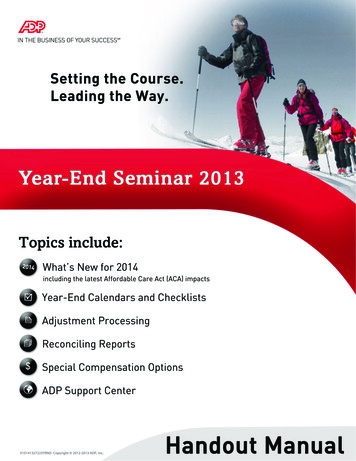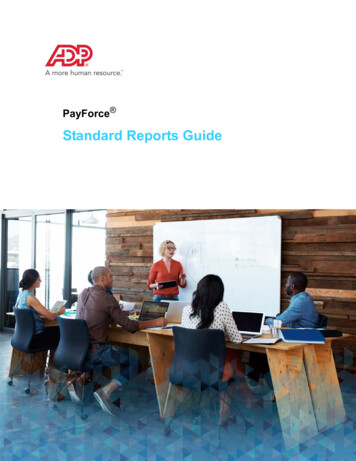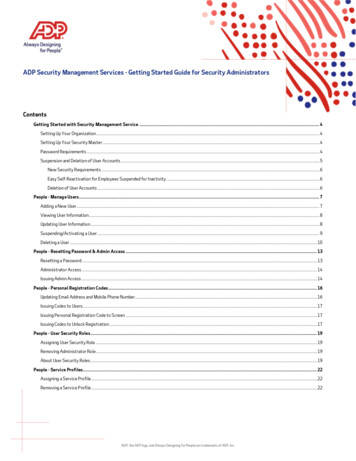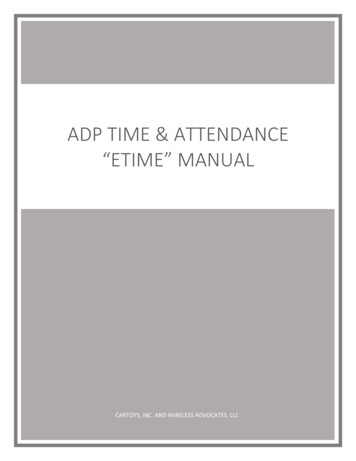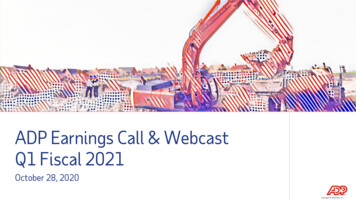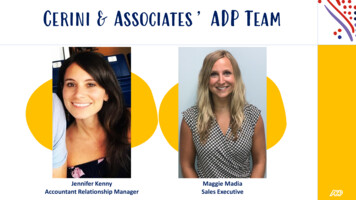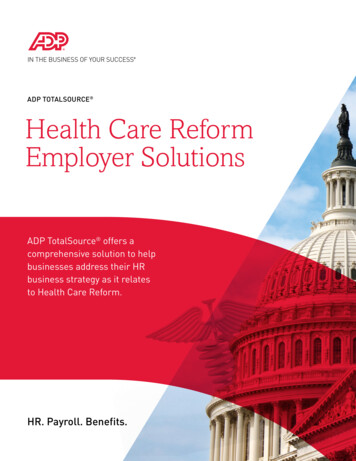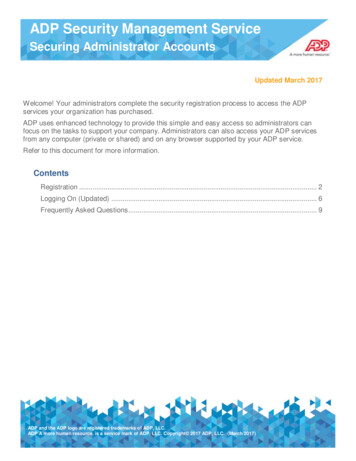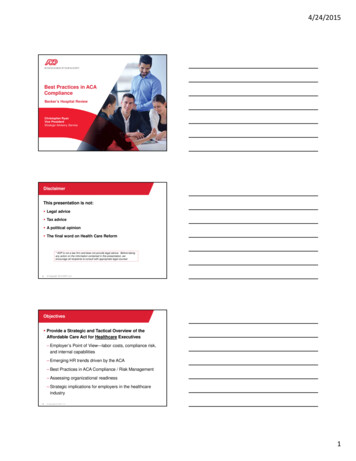
Transcription
4/24/2015Best Practices in ACAComplianceBecker’s Hospital ReviewChristopher RyanVice PresidentStrategic Advisory ServiceDisclaimerThis presentation is not: Legal advice Tax advice A political opinion The final word on Health Care Reform* ADP is not a law firm and does not provide legal advice. Before takingany action on the information contained in this presentation, weencourage all recipients to consult with appropriate legal counsel.2 Copyright 2015 ADP, LLCObjectives Provide a Strategic and Tactical Overview of theAffordable Care Act for Healthcare Executives– Employer’s Point of View—labor costs, compliance risk,and internal capabilities– Emerging HR trends driven by the ACA– Best Practices in ACA Compliance / Risk Management– Assessing organizational readiness– Strategic implications for employers in the healthcareindustry3 Copyright 2015 ADP, LLC1
4/24/2015ACA Impact For EmployersIt’s not just a Benefits problem Tax problem Compliance challengeFundamental Changes Workforce Management Total Reward Strategy Benefit Plan Design HR Technology / Process In the long run, the ACA will fundamentally change the way weapproach Human Capital Management.4 Copyright 2015 ADP, LLCADP RI Survey of Large Employers – 1/2015 85% of large employers plan to extend benefits to all ACA eligible employees 81% indicate that they will continue to utilize traditional H&W practices andservices—13 % are considering a public or private exchange solution 70% of large companies handle day-to-day ACA compliance tasks in-house, butonly 51% feel that their company is “extremely or very prepared” 53% of NAS employers have no plans to adjust employee hours Of the 39% who plan to change employee hours, 50% reported they will decreaseemployee hours, and 34% reported that they will increase employee hours.NAS (1K EE)(Among employers reporting they will make adjustmentsin response to the ACA)5IncreaseDecreaseDon’tknowChange employee deductible (n 256)73%18%9%Change employee co-pay (n 258)80%12%8%Change employer contributions (n 259)53%39%8%Change waiting period for coverage (n 262)42%24%34%Source: ADP Research Institute Copyright 2015 ADP, LLCACA OverviewHCMENABLERSACA PILLARSPART-TIM EFUL L -TIM NAGEMENTENROLLMENTWORKFORCEMANAGEMENTM A N D AT O R YThe Penalty Risks ELIGIBILITY – # of ACA full-time employees (-80 in 2015; 30 in 2016) X 2,000 annually. AFFORDABILITY – 60% Minimum Value, Safe Harbor Methods – 3,000 per Incidence.6 Copyright 2015 ADP, LLC2
4/24/2015Shared Responsibility (Employer Mandate):Decision Flow To Avoid Penaltiesst1CHECKEmployer has, on average, 100 in2015 (50 in 2016) ACA full-timeemployees plus full-time equivalentemployees in the prior year?YESnd2CHECKDoes the employer offer minimumessential coverage (MEC) to at least70% in 2015 (95% in 2016) of itsACA full-time employees?YESrd3CHECKDoes the plan provide coverage of atleast 60% minimum value?IRC §4980H(a) – “The Big Penalty”NOth4YESThe penalty (assessedmonthly) for not offeringcoverage is the number offull-time employees (minus80 in 2015; 30 in 2016)times 2,000 annuallyNOThe penalty (assessedmonthly) for failure to offerminimum value and/oraffordable coverage is a 3,000 annual penalty thatwill be due for each full-timeemployee receiving asubsidy, up to a maximumof the total number of fulltime employees (minus 80in 2015; 30 in 2016) times 2,000Those employees canchoose to buy coverage in aMarketplace/Exchange andmay receive a premium taxcreditWould any full-time employees paymore than 9.56% of current year forlowest cost self only coverage Box 1 W-2 Wages, Rate of pay, or Federal Poverty LevelDid at least one employeereceive a premium tax creditor cost-sharing subsidy in aMarketplace/Exchange?IRC §4980H(b) – “The Lesser Penalty”YESCHECKPenalties do not apply tosmall employers.NOYESNONo Penalty Payment Required7 Copyright 2015 ADP, LLCCompliance with Shared ResponsibilityRequirementsDraft 1095-C: Employee Statement to IRS and employee It’s All About Taxes—filings,reconciliations, audits, notices:– ACA Filings (1094-C, 1095-C)under penalty of perjury– ACA Full-Time status for eachemployee is required forreporting*Draft 1094-C: Employer Transmittal– Accountability for the accuracyand retention of all relevant HRrecords, including an audit trail Employee eligibility for tax creditsdependent upon employer reporting*Unless employer meets safe harbor guidelines8 Copyright 2015 ADP, LLCWhile Annual Health Care ReportsAre “W-2 like”, They Are Not SimpleAnnual reporting requirementsrequire data to be captured,tracked, and reported fromsystems of record in new waysAs a point of comparisonto Form W-2; W-2 fields come from 1 systemof record vs. up to 5 for annualIRS information reportingDataSource W-2 has field data mapping vs.derivation or calculation of datafor fields to populate from systemsof record to IRS ployer#* ofElements1095-CEmployee#* R, Payroll, and Finance teams that traditionally work in silos will need to worktogether as a team to generate 1095-C’s.9 Copyright 2015 ADP, LLC3
4/24/2015Report Timing And Potential Penalties First reports will be filed in 2016 for the 2015 calendar year Form 1095-C must be distributed to all covered participants by the end of January each yearand also filed with the IRSForm 1094-C must be filed with IRS ––February of each year for employers with fewer than 250 W-2sMarch of each year (electronically) for all other employersPenalties and Transition Relief – Penalties for failure to file on time will be 100 per form – not to exceed 1.5 million per year– No relief for late filing–10No penalties if employer has inadvertent errors or incomplete data but can demonstrate a good faitheffort to comply Copyright 2015 ADP, LLCThe Broader RealityBENEFITSREGULATORYMANAGEMENTPART-TIM EFUL L -TIM RKFORCEMANAGEMENTI/T INTEGRATIONSTRATEGY / PLANDESIGNTAX ANDRISKOPERATIONS ANDPAYROLLAdministrative Risks The IRS puts Burden of Proof on the employer. Employees will shop the exchanges, elect coverage and receive subsidies – triggering inquiry. New hires will come to employers with subsidized exchange coverage and opt out.11 Copyright 2015 ADP, LLCEmployer Exchange Notice and PenaltyManagement ProcessEMPLOYERCouldpotentiallyhave torespond to 18differentExchangesIRSEXCHANGEMARKETPLACEEmployer Regulatory Management Process – Penalty AppealEmployeeDeterminesgoes to 1 of 18ExchangedifferentStatenoticesare notand FederalExchangessubject to toobtainpenaltyfromcoverage andpreviousare granted aRegulatorypremium enalty notice)to employerRequestsanAccessesappealpayroll withinsystem90fromfor daysRegulatoryreceiptoftestingnoticeSends a timelyacknowledgement of ltyappealRegulatoryresolutiontestingStores allExchangeAccessesnotices in timeasystems ereferencePrepares for appealConductResearchesConductConductResponds to Documentsby collecting all Regulatoryandaccesses resolution forRegulatoryRegulatoryappropriateSends todocumentation fromExchangetesting onPreparesReceivestesting ontesting onExchangeeverypayroll system,employeesand Sends appealnotices,payrollMinimumannualsystem,MEC healthforbenefitsallof new penaltyAffordability forpenalty appealwithinthe employee insystem,benefitfilesIRS m,andfor documentExchangenotice to IRSall Exchange resolutionguidelinesofand 1094Cs to Exchange1094/1095Cs1094Cstonoticesnoticesthe specifictracking1094/1095Cssupport the penaltydetermine ifnoticesreceived appealreceivedExchangesystempenaltyis validreceivedCouldpotentiallyhave torespond to 18differentExchangesSends notification toemployer and employee ofappeal being accepted ordismissed (within 90 daysfrom receipt of appeal)Where an exchange hasnot establishedan employer appealsprocess, HHS will providean employer appealprocessReconciles annualExchange reports,employer reports(1094/1095Cs), healthinsurer reports(1094/1095Bs) andindividual tax returnsSends finalSends notification to employer ofSends a timelynotice of penalty penalty being valid or sends a NoticeBeginning in April 2016acknowledgemamount toof Dismissalpenaltyand ifcouldbeisseveralemployer afterent of appealinvalid/dismissed (within 90 daysmonths depending on IRS’sIRS reconciliationreceiptfrom receipt and appeal)process deadlinereconciliation process Copyright 2015 ADP, LLC4
4/24/2015ACA – Organizational ImpactTaxFinanceLegal Notice of Coverage Options Validating and ProcessingExchanges Notices Disputing and DocumentingExchange Notices Manage Reporting Deadlines /Period Management Responding to IRS PenaltyNotices Administrative Challenges Staff to Meet DemandsIT/SystemsHRPayrollTime & Absence ManagementBenefitsReportingPenalty ReconciliationNew Requirements13 Copyright 2015 ADP, LLCEffectively Managing the Complexities of ACARequires a Comprehensive ApproachExchangesEligibilityAffordabilityReporting andAnalyticsBenefitsRegulatoryManagement Notice ofCoverageIRS ExchangeManagement Annual ReportingHR PenaltyManagementPayrollI-9I-9 Data14LeavesTime Copyright 2015 ADP, LLCWhy Unpaid Leave Matters Unpaid leave directly impactsACA Full-Time status calculation Socio-demographic trends likely toincrease incidental absence FMLA and ACA both involve complexcompliance challenges Inconsistent record keeping practices—especially for PT / Variable HouremployeesNon-compliance of either onecould expose the other!15Hours of Service Hours Worked PaidLeave Special Unpaid Leave Copyright 2015 ADP, LLC5
4/24/2015Best Practices Set up a separate leave code for every type of leave, both paid andunpaid Proof of Offering Coverage:– Roll-over existing elections—does not address current waivers, newlyeligible– Bar-coded first class mail– Electronic distribution: Must comply with DOL requirements– Drop shipments: Must obtain employee signature– Actual affirmative elections made by employee For some employers declaring all employees ACA F-T and eligible formedical coverage may be less expensive than tracking hours of service16 Copyright 2015 ADP, LLCConsiderations for Healthcare Administrators Business case for technology investment– Compliance Risk– Due diligence prior to acquisition– Due diligence for liquidity events– Finance/Tax certification of IRS 1094C, 1095C Impact to business model– Use of PT workforce– Total Labor Cost17 Copyright 2015 ADP, LLCACA—Things to Review Now Sources of data to complete IRS Forms1094-C, 1095-C, including proof ofeligibility, affordability, offer of coverage, and plan compliance withminimum effective coverage Accountability within your organization for ACA tax filings, includingreconciliation, IRS inquiries, and management of audits. (Who signs theforms? Who responds to the IRS?) Mechanism to research and respond to notice of coverage inquiries fromstate exchanges Accuracy of unpaid leaves data (FMLA, USERRA, Jury Duty), if using alook back approach to establish eligibility of variable hour workers. Allleave types need to be separately identified.18 Copyright 2015 ADP, LLC6
4/24/2015Best Practices Integrated Time & Labor, Payroll, HR, Benefits, andAbsence/Leaves Systems:– Single point of entry– Data flow downstream from single source– Automatic reconciliation at point of entry– Defined audit trail for transactions, events, and communications Systemic enforcement of federal / state leave laws as well ascompany policies Consistent tracking of all types of paid / unpaid leave Are compliance risks fully identified and understood?19 Copyright 2015 ADP, LLCACA Impact on Health Premiumsand the 2018 Excise Tax20 Copyright 2015 ADP, LLCEmployer Sponsored Insurance—in PerspectiveCore to the U.S. Health Care SystemCovers roughly 149 million non-elderly workingAmericans and their dependents, funding 38% ofU.S. healthcare GDP.Comprises 8.5% of total U.S. compensation costs, perannum, up from 4% in 1990’s.Shields income from roughly 185 Billion in taxreceipts annually, but subject to an estimated 120Billion in provider cost-shifting for un/under-insuredUnique to U.S. as a primary source of coverage forthe non-elderly. Remains single most popular fringebenefit, closely tied to recruiting/retention.21 Copyright 2015 ADP, LLC7
4/24/2015Risk Factors for Employers: Location in high cost statesHealth Plans with low co-pays / deductiblesAging workforce / presence of chronic conditionsLimited tools/emphasis on preventive healthNo controls for cost / quality review—especially forcatastrophic cases Copyright 2015 ADP, LLC22Excise Tax Goals Slow the rate of health care cost increases For 50 consecutive years, per capita health care spending hasincreased faster than inflation as measured by the CPI 1 and 2 Generate revenue to offset some of the costs associated with the ACA The Congressional Budget Office (CBO) estimates the excise tax will result in 120 billion in new tax revenue between 2018 and 20243– 25% of the 120 billion, or about 30 billion, will come directly from employers, third partyadministrators (TPAs), and issuers paying the tax on plans that exceed the limits– The remaining 75 percent, or 90 billion will come from increased income and payroll taxrevenue from the higher taxable wages employers are predicted to pay to offset the reduction inthe health care benefits expected to occur Cap the amount of tax-free benefits that can be provided in the form of employersponsored health care The current tax exclusion for employer provided health benefits reduces federal andstate tax revenues by 260 Billion per year and is the government's third largestexpenditure on health care, after Medicare ( 400 Billion) and Medicaid ( 300 Billion)4Sources:1. Per Capita National Health Expenditures (NHE) - Centers For Medicare and Medicaid Services, Office of the Actuary, National HealthStatistics Group, U.S. Department of Commerce, Bureau of Economic Analysis2. Percent Change in CPI (All Items and Medical Care) – U.S. Dept of Labor, Bureau of Labor Statistics3. Congressional Budget Office, The Budget and Economic Outlook: Fiscal Years 2014 to 2024, Table 2-1, February 2014.4. The National Bureau of Economic Research, http://www.nber.org/bah/2010no1/w15766.html23 Copyright 2015 ADP, LLCACA and Evolution of Plan Design Imposes upper/lower limits onpre-tax contributions– Total Medical premiumsHigh Cost Plan– Squeezes plan design into anarrower band of values Strong incentive to manage healthcosts– Self-Funding / CDHAverage PlanRisk of Excise Tax– Pre-tax HSA/FSA/LFSA– Other self-funded plan costsLow Cost Plan100%90%Actuarial 80%CoverageValue70%60%– Dependent Verification– Premium differentials for healthybehaviorsBelow MEC Standard50%2016 2017 2018 2019 2020 2021 2022– Population health management– Provider selection tools24 Copyright 2015 ADP, LLC8
4/24/2015Strategic Considerations for the HealthcareIndustry Some employers consistently pay 25% to 50%less for equivalent health 1,500.00– Potential source of competitive advantage forthe industry/geographic cost leader 1,300.00– High cost employers face 2018 excise tax—willeither adjust practices, or be forced out of thebenefits market Cost variances due to procurement, funding,plan design, and health prevention strategies. Hospitals may face greater risks with 2018Excise tax 1,100.00 900.00 700.00 500.00 300.000.00 0.50 1.00 1.50 2.00 2.50Source: ADP Research Institute– Health professionals / bargaining units tend toincur higher health costs compared to otherworkforcesDistribution of average monthly premiumsper employee for 200 employers, plottedagainst average number of dependents– CDH plans face cultural resistance in healthcareenvironments25 Copyright 2015 ADP, LLCGrowth of CDHP Excise Tax will accelerate use of CDHP KFF 2014 survey results:– 43%* of firms with 1000 – 4,999 lives offer anHDHP with spending account– 50%* of firms with 5000 lives offer an HDHPwith spending account– 20%* of participating employees in firms 200lives have an HRA/HSA Usage of CDH plans varies significantly byregion and employerSOURCE: Kaiser/HRET Survey of Employer-Sponsored Health Benefits, 2006-2014.– Major change management issues with keyindustries, populations*SOURCE: Kaiser/HRET Survey of Employer-Sponsored Health Benefits, 201 4 Copyright 2015 ADP, LLC26Key Trends in Health Benefits – 2013 - 2015Source: ADP Annual Health Benefits Report, 2015ADP Research institute,27 Copyright 2015 ADP, LLC9
4/24/2015Key Trends in Health Benefits – 2013 - 2015Source: ADP Annual Health Benefits Report, 2015ADP Research institute,28 Copyright 2015 ADP, LLCPercentage of Workers in 30-34 Hour Cohort byIndustry (Q3 2013, Q3 2014)All Q3 2013 part timeAll Q3 2014 part time30-34 hoursThere is minimal evidence thatthe ACA will alter the mix offull time and part-timeemployment.Source: ADP Research Institute Copyright 2015 ADP, LLC29Closing Thoughts For hospitals and care facilities, the classification of part time workers, compliancetracking, and the 2018 excise tax will be major issues. The ability of employers to keep part time employees below the 30 hour threshold toqualify for health benefits may be limited by labor shortages in key age brackets. Most working age patients with employer sponsored health insurance will have highdeductible health plans, with direct impact on:– Greater pressure on receivables– Consumer demands for simplicity and transparency of billing– Changes in doctor / patient protocols to include discussions of cost of treatment– Greater consumer awareness of healthcare employment practices and linkage topatient outcomes.30 Copyright 2015 ADP, LLC10
4/24/2015Thank YouFor additional ACA insights and tosubscribe to ADP’s Eye on Washingtonregulatory alerts and visit:www.adp.com/eyeonwashingtonPlease visit www.adp.com/acafaqs fora current list of ACA Frequently Asked Questions.The use of the HRCI seal is not an endorsement by the HR Certification Institute of the quality of the program. It means that this program has met the HRCertification Institute's criteria to be pre-approved for recertification credit. The ADP logo, ADP, ADP Research Institute and In the Business of Your Success areregistered trademarks of ADP, LLC. This material is subject to change and is provided for informational purposes only and nothing contained herein should betaken as legal opinion, legal advice, or a comprehensive compliance review. Copyright 2014 ADP, LLC.31 Copyright 2015 ADP, LLC11
ELIGIBILITY – # of ACA full-time employees (-80 in 2015; 30 in 2016) X 2,000 annually. AFF


